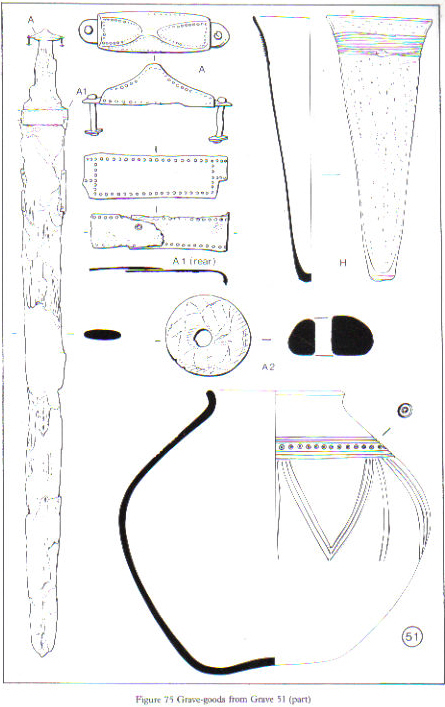Posts: 95 Location: Suffolk, England
Sun 07 Oct, 2012 4:09 am
Scabbard decoration from Westgarth Gardens grave 51
Hello1 does anyone have any info to elaborate upon the hardly obvious decoration on the scabbard from grave 51 Westgarth gardens Bury st Edmunds, i only have one image from an east anglian archaeology book about the site, and have only just been able to realise that it isn't degredation of the scabbard, but seems to be decoration standing proud in what looks like radiating lines from the mouth end down to the chape end.
If anyone can elaborate upon the scabbard i would be very grateful (Mr bunker if youre out there im sure you'll have something up your sleeve!)
 Attachment: 186.84 KB
Attachment: 186.84 KB

here is a scanned copy of the only image i have, which hasn't scanned that well ;S
Posts: 483 Location: Somerset UK
Mon 08 Oct, 2012 5:33 am
Hi Kaj,
The sort of simple radiating line pattern on the Westgarth Gardens example is the commonest type found on scabbards of this period. Sometimes you get a single line from top to bottom, more often (and I say "more often" in the loosest possible sense as the number of Anglo-Saxon scabbards with surviving decoration is tiny) you get this radiating pattern ( I have an unprovable theory about what this pattern represents).
In the later 6th and 7th century, this patterning was created using cordwork, glued to the scabbard underneath the leather/hide cover but in early examples (like this one, Spong Hill grave 40 and Watchfield grave 2), it's produced by carving directly into the face of the wooden lath. Presumably this is the last phase of a tradition that goes back to the very elaborately carved wooden scabbards found in the Danish bogs, at which point the scabbard makers realised that they were wasting their time turning 90% of the wooden lath into shavings and that they could achieve the same effect with string.
What I like about the Westgarth find is that, like the Feltwell, it's an example of something not especially well made (especially the scabbard mouthband).
BTW, the glass bucket on the cover of the find report? They sold that about 8 years, ago...for £116,000.
Posts: 95 Location: Suffolk, England
Mon 08 Oct, 2012 11:10 am
Thanks Mr bunker, i knew you'd come through!
i have a file of images on my pc for knife,sword and scabbard pics, many of them have the cordwork and i do have images of the danish finds with the caved laths, i'd be very interested in hearing your theory on what the possible reasons are for this, many historians wouldn't dare have ideas about such things and those who do often use vague terms like "ritual or religious significance" so a proper idea is always welcome.
i have a very similar feeling about the feltwell and westgarth swords, as you have probably realised considering my previous questions about the feltwell villa sword. They show more of the norm than what people usually show in reenactment, and in my case more local - and the organic hilts interest me more than metal and gemstones.
Do you reckon the bucket was a situla? it's certainly kept its price, it would have been even more spectacular new, especially in early saxon Anglia. :)
Posts: 530
Mon 08 Oct, 2012 11:14 am
Interesting that in Sweden, it would seem, they stayed with the carving on scabbard slat itself for longer than that - there is evidence of carving on the scabbard surface itself on all of the Valsgarde sword sheaths I have seen in person.
Last edited by Artis Aboltins on Mon 08 Oct, 2012 11:18 am; edited 1 time in total
Posts: 483 Location: Somerset UK
Mon 08 Oct, 2012 11:17 am
| Artis Aboltins wrote: |
| Tnteresting that in Sweden, it would seem, they stayed with the carving on scabbard slat itself for longer than that - there is evidence of carving on the scabbard surface itself on all of the Valsgarde sword sheaths I have seen in person. |
Very true, the V7 being the finest example I think. I'm afraid I cheated when I copied it, my leather carving skills being far superior to my woodcarving ones.
Posts: 530
Mon 08 Oct, 2012 11:21 am
| Matthew Bunker wrote: |
| Artis Aboltins wrote: | | Tnteresting that in Sweden, it would seem, they stayed with the carving on scabbard slat itself for longer than that - there is evidence of carving on the scabbard surface itself on all of the Valsgarde sword sheaths I have seen in person. |
Very true, the V7 being the finest example I think. I'm afraid I cheated when I copied it, my leather carving skills being far superior to my woodcarving ones. |
\
Sadly, Valsgade 8 scabbard is in far worse state than Valsgarde 7, but it was, aparently, also covered entirely in carving, covered with leather. Same with Valsgarde 6.
You
cannot post new topics in this forum
You
cannot reply to topics in this forum
You
cannot edit your posts in this forum
You
cannot delete your posts in this forum
You
cannot vote in polls in this forum
You
cannot attach files in this forum
You
can download files in this forum

